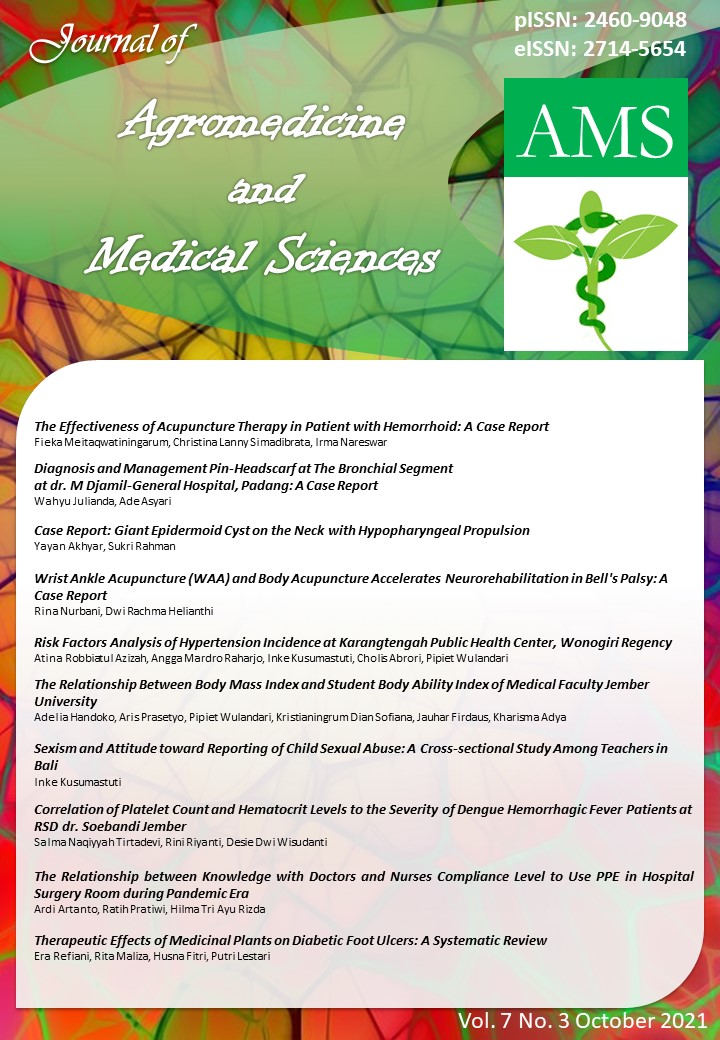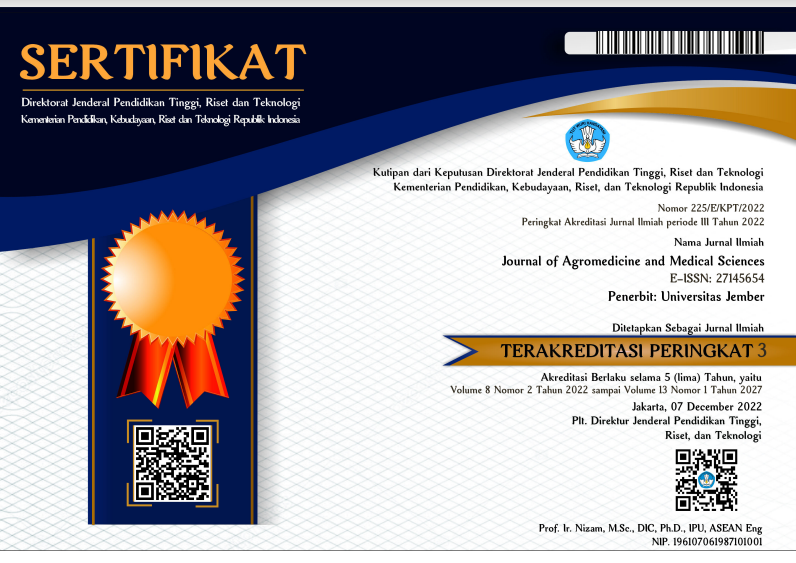The Relationship Between Body Mass Index and Student Body Ability Index of Medical Faculty Jember University
DOI:
https://doi.org/10.19184/ams.v7i3.23785Abstract
Technological advances in recent years have had an impact on people's lifestyles. Almost all activities in various sectors can be carried out and accessed via smartphones. This causes a decrease in physical activity which can lead to obesity. Obesity is an imbalance of energy entering the energy used in the body resulting in the accumulation of excess lipids which can interfere with the health condition of the body. Body composition is an important part of determining one's physical fitness. Body composition can be seen from a person's Body Mass Index (BMI). This type of research is analytic observational with cross sectional research design. The data used by researchers is secondary data in 2018. The sampling technique used is purposive sampling. The sample used in this study was 127 people, consisting of 47 men and 84 women. Data were analyzed using SPSS version 26 through the Spearman Analysis Test with the results of p = 0.000 (p-value <0.05) for the relationship between BMI and IKB in the slow way and p = 0.002 (p-value <0.05) for the relationship between BMI with IKB the fast way. The conclusion that can be drawn from the results of the analysis is that there is a weak correlation between body mass index and body fitness index on the Havard Step Test fitness test for students of the Faculty of Medicine, University of Jember.
Keywords: body mass index, harvard step test , physical fitness
Downloads
References
Alfarisi, R. dan P.P. Rivai. 2017. Hubungan Indeks Massa Tubuh terhadap Ketahanan Kardiorespirasi Diukur dari VO2Max pada Mahasiswa Fakultas Kedokteran Universitas Malahayati. Jurnal Ilmu Kedokteran dan Kesehatan. 4(2): 67-73.
Aphamis, G. Giannaki, C.D. Tsouloupas, C.N. Loannou, Y. dan Hadjicharalambous, M. 2014. The relationship between physical fitness and obesity among a sample of adolescents in cyprus. Int J Adolesc Med Health.http:// dx.doi.org/10.1515/ijamh-2014-0054
Arum, V. M., dan T. Mulyati. 2014. Hubungan Intensitas Latihan, Persen Lemak Tubuh, dan Kadar Hemoglobin dengan Ketahanan Kardiorespirasi Atlet Sepak Bola. Journal of Nutrition College. 3(1): 179-183.DOI:https://doi.org/10.14710/jnc.v3i1.455
Bircher, S. Hill, A. Coates, A. 2011. Relationships between Obesity, Cardiorespiratory Fitness, and Cardiovascular Function. Journal of Obesity. Volume 2010, Article ID 191253, 7 pages doi:10.1155/2010/191253
Chatterjee S, Chatterjee P, Bandyopadhyay A. 2005. Cardiorespiratory fitness of obese boys. Indian J Physiol Pharmacol49(3):353-357.
Departemen Kesehatan Republik Indonesia. Petunjuk teknis pengukuran kebugaran jasmani, Jakarta: Depertemen Kesehatan. 2005.
Dewi, M., Kustiyah, L., Kuswari., M. 2015. Percent Fat Mass and Body Mass Index as Cardiorespiratory Fitness Predictors In Young Adults. J. Gizi Pangan, November 2015, 10(3): 179-184. DOI:https://doi.org/10.25182/jgp.2015.10.3.%25p
Dobner, J. dan S. Kaser. 2018. Body Mass Index and The Risk of Infection-From Underweight to Obesity. Elsevier. 24-28.doi: 10.1016/j.cmi.2017.02.013.
Eather, N.,Morgan, P.J., Lubans, D.R. Improving health-related fitness in adolescents: The CrossFit Teens randomised controlled trial. J. Sports Sci. 2016, 34, 209–223. doi: 10.1080/02640414.2015.1045925.
Fazanes, A.C., Diaz, J.R., Furelos, R.B., Rey. E., Fernadez, J.E.R., Casal. C.V., Gomez., C.A. 2020. Physical Activity Habits and Determinants, Sedentary Behaviour and Lifestyle in University Students. Int. J. Environ. Res. Public Health 2020, 17, 3272; doi:10.3390/ijerph17093272
Frank, Q.N. Body Mass Index Obesity, BMI, and Health: A Critical Review. Nutr. Today 2015, 50, 117–128.DOI:10.1097/NT.0000000000000092
Gajewska E, Kalinska K, Bogdanski P, Sobieska M. 2015. Cardiorespiratory endurance in relation to body mass in Polish rural children: Preliminary Report. Homo 66(3):278-285.DOI:10.1016/j.jchb.2015.02.001
Guyton, A.C. dan J.E.Hall. Guyton and Hall Textbook of Medical Physiology. 2014. Twelfth Edition. Singapore:Elsevier. Terjemahan oleh Ilyas dan E.I.I. 2014.Guyton dan Hall Buku Ajar Fisiologi Kedokteran. Edisi12. Indonesia: Saunders Elsevier.
Hsieh, P. Chen, M. L.Huang, C. M.Chen, W. C.Li ,C. H.Chang,L.C. 2014. Physical activity, body mass index, and cardiorespiratory fitness among school children in Taiwan: A Cross-Sectional Study. Int J Environ Res Public Health 11(7): 275-285. http:// dx.doi.org/10.3390/ijerph110707275.
Irianto, D. P. 2017. Panduan Gizi Lengkap (Keluarga dan Olahragawan). Yogyakarta: Andi Yogyakarta.
Kementerian Kesehatan RI. 2014. Profil Kesehatan Indonesia Tahun 2013. Jakarta: Kementerian Kesehatan Republik Indonesia.
Kementrian Kesehatan Republik Indonesia. 2018. Epidemi Obesitas. Jakarta
Lavie, C.J. McAuley, P.A. Church, T.S. Milani, R.V. Blair, S.N. Obesity and cardiovascular diseases: Implications regarding fitness, fatness, and severity in the obesity paradox. J Am Coll Cardiol2014;63(14):1345–54.doi: 10.1016/j.jacc.2014.01.022
Lavie, C.J. Carbone, S. Kachur, S. 2019. Effects of Physical Activity, Exercise, and Fitness on Obesity-Related Morbidity and Mortality. Exercise is Medicine. Volume 18. Number 8. doi: 10.1249/JSR.0000000000000623.
Mexitalia, M., M.S. Anam, U. Asuza, dan Y. Taro. 2012. Komposisi Tubuh dan Kesegaran Kardiovaskuler yang Diukur dengan Harvard Step Test dan 20 mShuttle Run Test pada Anak Obesitas. Media Medika Indonesia. 46(1):12-19.
McAuley, P.A. Beavers, K.M. Contribution of cardiorespiratory fitness to the obesity paradox. Prog Cardiovasc Dis 2014; 56(4):434–40. doi: 10.1016/j.pcad.2013.09.006.
Prasetio, E. 2017. Tingkat Kebugaran Jasmani Berdasarkan Indeks Massa Tubuh pada Siswa SMP Negeri 29 Bengkulu Utara. Jurnal Ilmiah Pendidikan Jasmani. 1(2): 86-91.
Sherwood, L.Z. 2014. Fisiologi Manusia dari Selke Sistem. Edisi 8. Jakarta: Buku Kedokteran EGC. Sulistiono. 2014. Kebugaran Jasmani Siswa Pendidikan Dasar dan Menengah di Jawa Barat.























